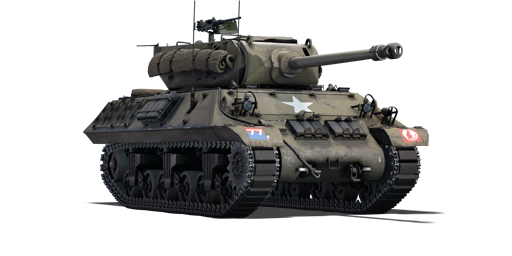


The Achilles (65 Rg.) (shortened to Achilles (65 Rg.), full name 17 pounder, Self-Propelled M10 Achilles (65th Anti-Tank Regiment)) is a premium gift British tank destroyer. It was introduced as a premium pack in Update 1.53 "Firestorm" and removed from the store after the 2017 Victory Day sale. It has also been obtainable in the Warbond shop in January 2018, November 2018 and November 2019. It was also made available briefly in the store during the 2020 D-Day sale and 2023 D-Day sale.
It was one of the first British tanks introduced in the game as an Achilles tank destroyer with the insignia of 7th Armored Division, 65th Anti-Tank Regiment "Norfolk Yeomanry".
The Achilles is based on the American M10 GMC, but carries a 17-pounder cannon as the main armament, making it an effective tank destroyer. Thanks to a well assigned BR, the Achilles won't feel in the wrong game even when facing higher rank tanks. The Achilles has plenty of firepower, as the Mk.8 APCBC shot is more effective against the T-34's sloped armour. The 17-pdr cuts through enemy Panzer III and IV (the shots enter the front and exit from the rear) so try to aim vital points to cause the maximum damage (first shot to the turret to disable enemy firepower). The T-34 is a bigger problem due to its sloped armour. When facing Soviet tanks, the first shot should always be to the gunner. The Mk.8 APCBC is quite able to penetrate the T-34 glacis even from a distance but keep in mind that the damage caused is unreliable (sometimes two or more shots are required to destroy a T-34). The M10 mobility is not outstanding, but the Achilles is pretty capable to carry the player, the gun, and the team to where it needs to go.
Protection is not good. The sloped armour and the track links added to the front will protect the Achilles from some low calibre shots, but the vast majority of the enemies will be able to destroy the Achilles easily. Side armour is paper thin. The high profile and the very slow turret traverse (man-powered) are not suitable for close range combat so avoid deep flanking tactics.
| Ammunition | Type | Armor penetration (mm) at a distance: | |||||
|---|---|---|---|---|---|---|---|
| 10 m | 100 m | 500 m | 1000 m | 1500 m | 2000 m | ||
| AP | 171 | 168 | 155 | 139 | 126 | 113 | |
| HE | 20 | 20 | 18 | 16 | 15 | 13 | |
| APC | 171 | 168 | 155 | 139 | 126 | 113 | |
| APCBC | 190 | 187 | 172 | 155 | 140 | 126 | |
| Smoke | 3 | 3 | 3 | 3 | 3 | 3 | |
| Belt | Belt filling | Armor penetration (mm) at a distance: | |||||
|---|---|---|---|---|---|---|---|
| 10 m | 100 m | 500 m | 1000 m | 1500 m | 2000 m | ||
| API-T/I/AP/API-T | 31 | 29 | 21 | 14 | 9 | 6 | |







 2 x (75 / 115 / 155) %
2 x (75 / 115 / 155) % 
 2 x 136 %
2 x 136 % 

Mobility | |
|---|---|
Protection |
|---|
Firepower | |
|---|---|